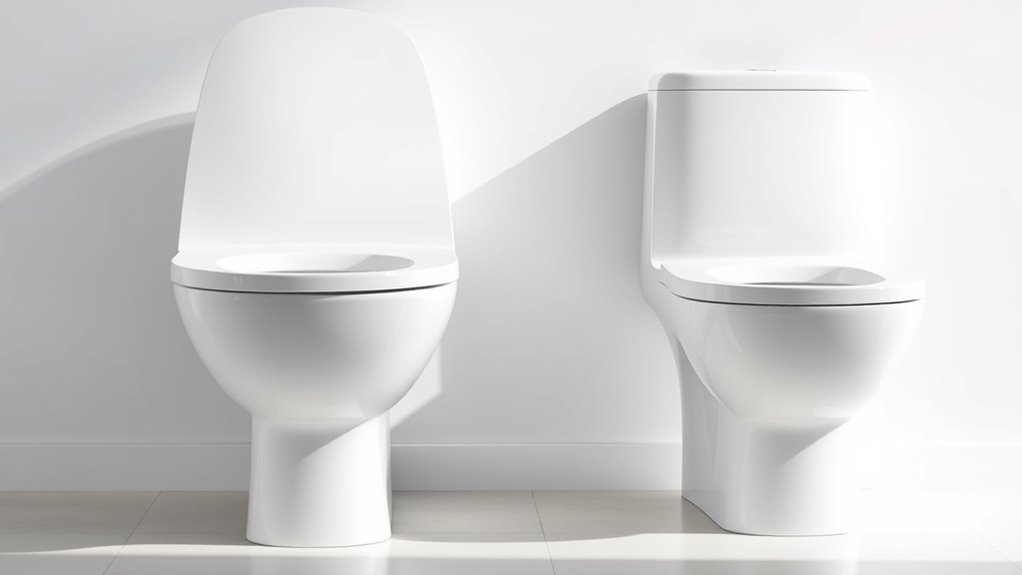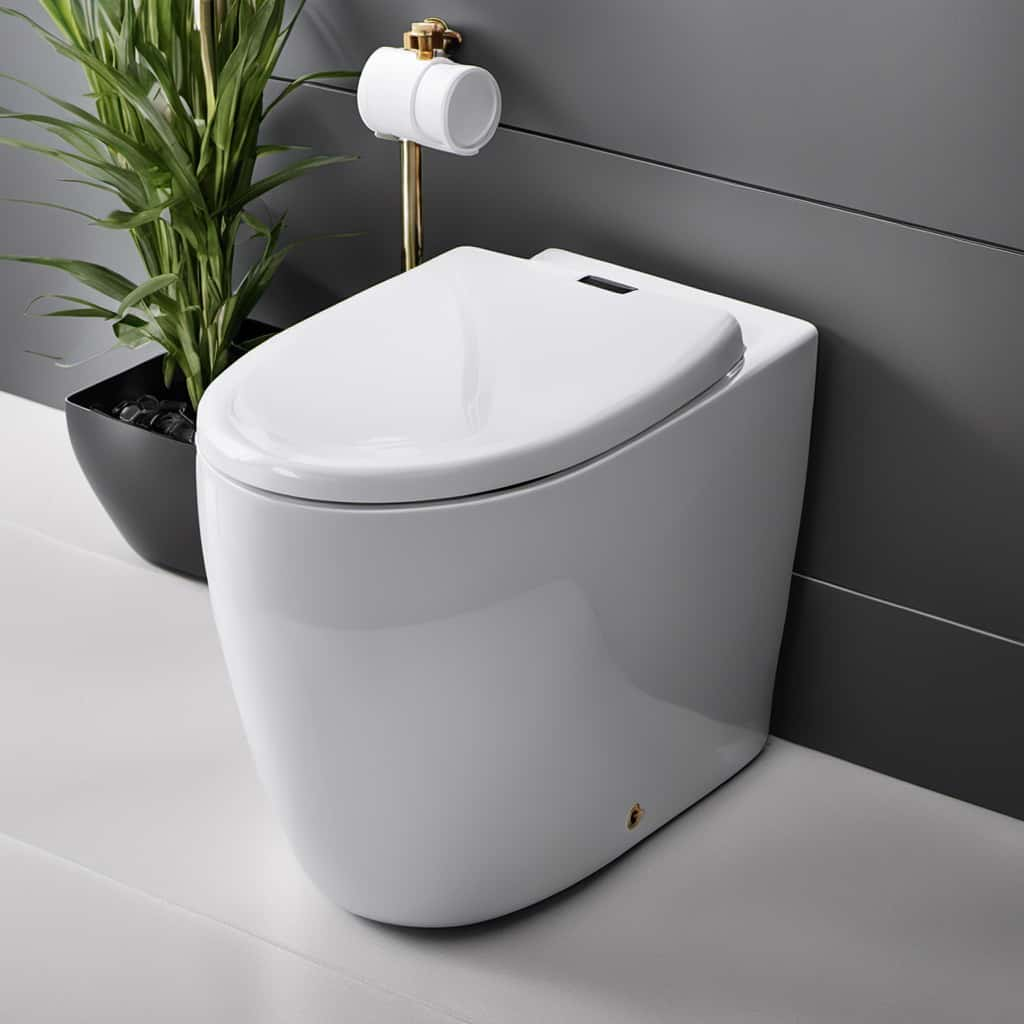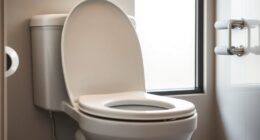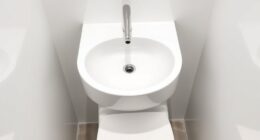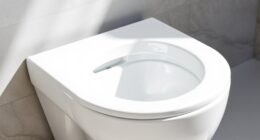Dual flush toilets give you two flush options, helping you save water when compared to single flush models that use a fixed amount per flush. The dual system reduces water use for liquid waste and conserves more with a powerful flush for solids. Overall, dual flush toilets are more efficient and environmentally friendly, lowering utility bills. If you want to learn how these differences impact your household and savings, keep exploring the details.
Key Takeaways
- Dual flush toilets use less water overall by offering separate options for liquid and solid waste, saving more than single flush models.
- Single flush toilets typically use a fixed amount of water per flush, often resulting in higher water consumption.
- Dual flush models can reduce household water usage by up to 67%, supporting environmental conservation.
- The efficiency of water savings depends on user behavior; dual flush toilets encourage more mindful water use.
- Both types impact water bills, but dual flush toilets generally provide greater long-term savings through reduced water consumption.
How Do Dual and Single Flush Toilets Differ in Design?
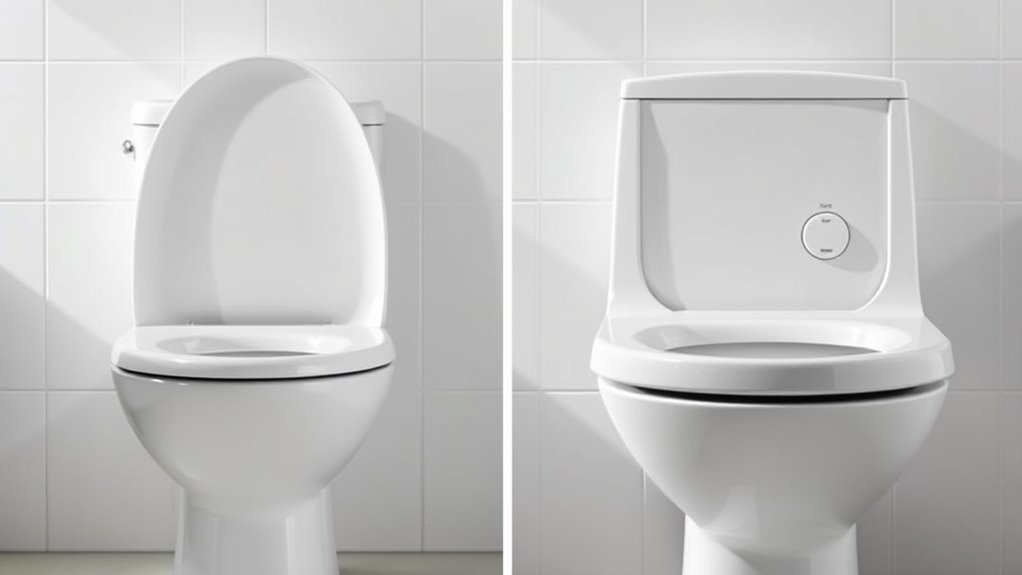
While both dual and single flush toilets serve the same basic purpose, their designs differ considerably. The main difference lies in their toilet design and flushing mechanism. Single flush toilets have one flush button or lever that releases a fixed amount of water, making them simple but less flexible. Dual flush toilets feature two buttons or levers, allowing you to choose between a light flush for liquids and a full flush for solids. This dual-option system enhances water efficiency. The flushing mechanism in dual toilets is often more complex, incorporating separate pathways for each flush type, while single flush models rely on a single, consistent mechanism. These design choices directly impact water usage and overall functionality, setting the two types apart.
Water Usage per Flush: A Comparative Overview
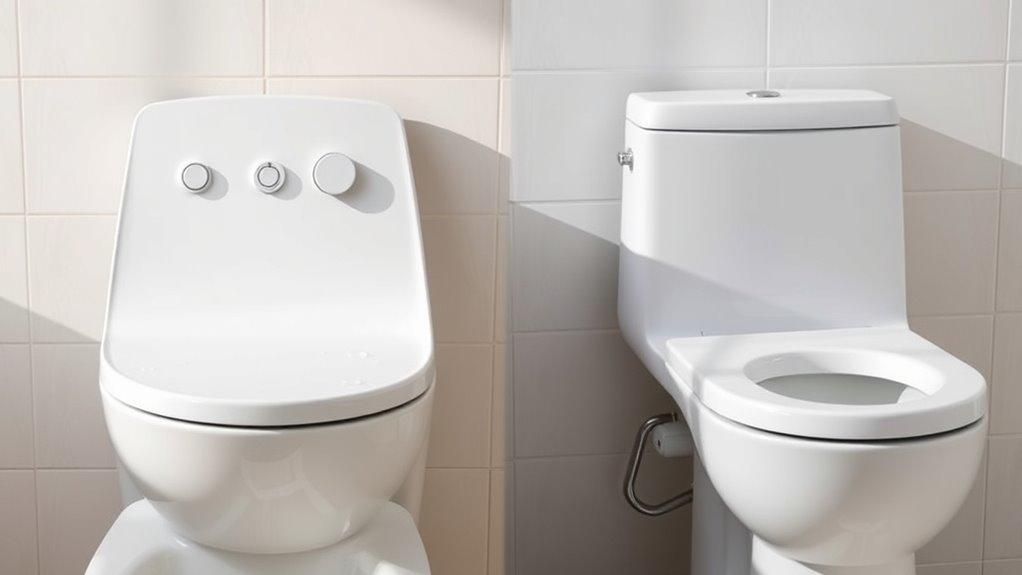
The design differences between dual and single flush toilets directly influence how much water each flush consumes. Dual flush toilets typically use less water because they offer two flushing options—one for liquid waste and one for solids—optimized by their flushing mechanisms. Single flush toilets usually have a fixed amount of water per flush, which often results in higher water usage. When considering water conservation, dual flush models can save significant amounts of water annually. Additionally, water-saving fixtures like dual flush toilets are an effective way to promote sustainability in home and commercial environments, especially when combined with other water-efficient technologies. Incorporating water conservation practices can further maximize the benefits of using these fixtures and contribute to a more sustainable water management strategy. Moreover, the integration of automation in plumbing can enhance water efficiency by ensuring optimal flush volumes based on usage patterns.
Environmental Impact of Each Toilet Type

Choosing between dual flush and single flush toilets considerably impacts the environment because water conservation reduces strain on natural resources. Dual flush toilets typically use less water per flush, lowering your carbon footprint and supporting recycling programs that promote sustainability. By conserving water, you help reduce the energy needed for water treatment and transportation, further decreasing environmental harm. Here’s a simple comparison:
| Aspect | Impact |
|---|---|
| Water Usage | Less with dual flush, reducing resource depletion |
| Carbon Footprint | Lower with dual flush due to reduced water processing |
| Recycling Programs | Supportive, less waste from water savings |
| Environmental Strain | Decreases as water consumption drops |
Additionally, understanding the contrast ratio of your toilet’s flushing mechanism can help you select models that maximize efficiency and performance. Being aware of the water-saving features incorporated into modern toilet designs can also guide environmentally conscious choices, especially those designed with eco-friendly materials that further reduce environmental impact. Incorporating smart technology into toilet designs can enhance water efficiency and user experience. Furthermore, selecting toilets with durable components ensures longevity, reducing waste and the need for frequent replacements.
Cost Analysis: Initial Investment and Long-Term Savings
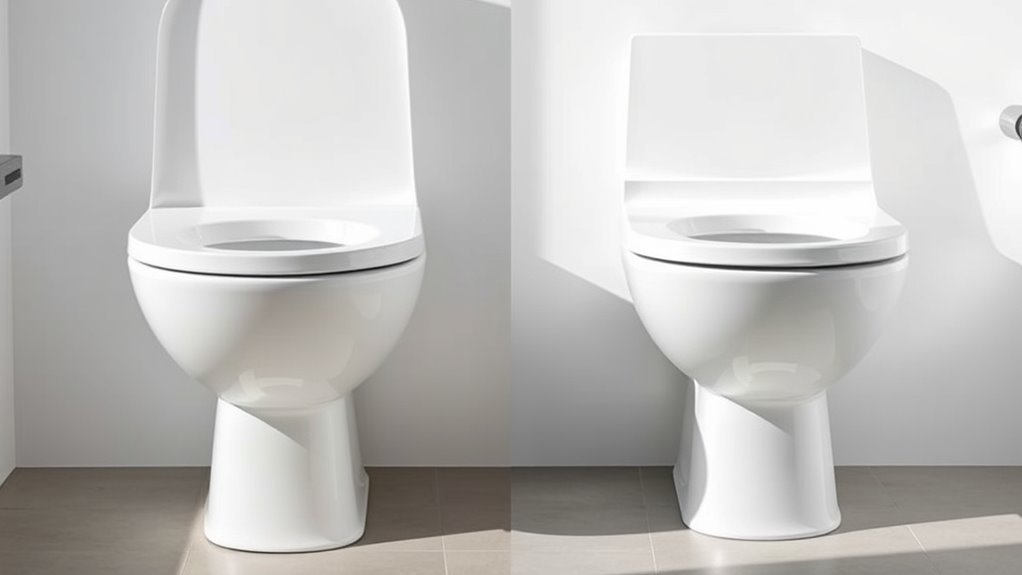
Although dual flush toilets often have a higher upfront cost, they can save you money over time through reduced water bills. Your initial investment varies depending on the brand reputation and pricing strategies, but the long-term savings make it worthwhile. To maximize your savings, consider these factors:
- Pricing strategies of different brands influence upfront costs and value.
- Brand reputation often indicates durability and efficiency, affecting long-term savings, especially when considering warranty coverage and customer support.
- Some models offer rebates or discounts, reducing initial expenses.
- Maintenance costs tend to be lower with reputable brands, saving you money over time.
- Additionally, water-saving features in some models contribute significantly to lowering your overall water consumption and expenses.
- Incorporating smart water management techniques can further optimize water usage and enhance savings over the lifespan of your toilet.
- Being aware of regulatory standards can help you select more efficient and compliant models, maximizing savings and environmental benefits.
Ease of Use and Maintenance Considerations
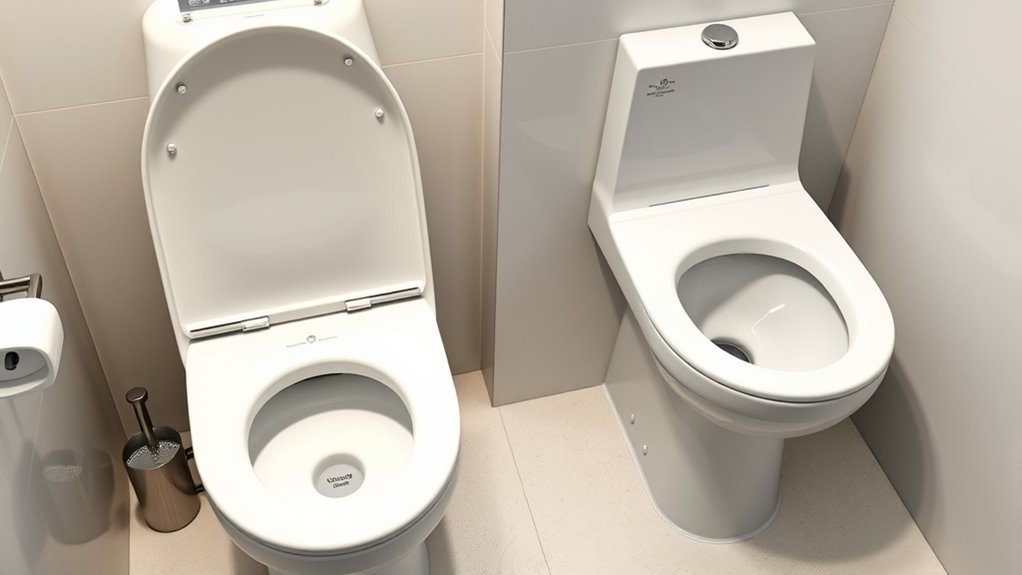
When evaluating dual flush and single flush toilets, ease of use and maintenance are key factors that can influence your overall satisfaction. You’ll want a toilet that’s simple to operate, with a comfortable flushing mechanism that suits your habits. Dual flush models often have a more complex cleaning process due to additional components, which might require more frequent maintenance. Single flush toilets tend to be more straightforward, making them easier to keep clean and maintain over time. User comfort also plays a role—look for smooth, easy-to-press buttons or levers that reduce strain. For example, some models incorporate advanced flushing technology, which can improve performance and reduce maintenance needs. Additionally, considering security zone information can help you select reliable, durable components that withstand regular use and minimize repair costs. Regular cleaning and inspecting the internal mechanisms can extend the lifespan of your toilet and ensure optimal operation. Properly managing refrigerant usage in the system can also support the longevity and eco-friendliness of your fixtures. Incorporating features like water-efficient components can further enhance the longevity and sustainability of your fixture. Overall, choosing a toilet that’s easy to operate and maintain ensures a hassle-free experience and keeps your bathroom cleaner with less effort.
Making the Right Choice for Your Home

When choosing between dual flush and single flush toilets, you should consider the initial costs and installation process to accommodate your budget. Water efficiency benefits can help save money over time, but it’s also important to evaluate each option’s maintenance needs and durability. Making the right choice ensures your home stays efficient, reliable, and cost-effective in the long run. Additionally, understanding flushing mechanisms and their effectiveness can help you select the most suitable toilet for your needs. Considering toilet cleaning features and ease of maintenance can further influence your decision, ensuring your toilet remains hygienic with minimal effort.
Cost and Installation
Choosing between dual flush and single flush toilets involves contemplating both the upfront costs and installation requirements. The cost comparison varies: dual flush toilets tend to be slightly more expensive initially, but potential savings offset this over time. The installation process for either type is straightforward but may require professional help, especially if replacing an old toilet. Factors to consider include:
- The complexity of existing plumbing
- Compatibility with your bathroom setup
- Cost of additional parts or modifications
- Time needed for installation
While dual flush models might have a higher purchase price, they often save money long-term through water conservation. Single flush toilets are generally cheaper upfront and easier to install, making them a practical choice if budget is a priority. Additionally, understanding the design features of each type can help you make an informed decision suited to your household’s needs.
Water Efficiency Benefits
Water efficiency is a key factor to contemplate when selecting between dual flush and single flush toilets. Dual flush models use less water per flush, making them ideal for conserving resources. If you’re interested in greywater recycling, dual flush toilets can integrate smoothly into your system, further reducing water waste. Additionally, the materials of your toilet bowl influence water efficiency; smooth, non-porous toilet bowl materials minimize residue buildup, ensuring efficient flushing with less water. Choosing a toilet with water-saving features can notably lower your household water usage and utility bills. By prioritizing water-efficient options, you help protect your local water supply and reduce environmental impact, making your home more sustainable. Overall, the right choice supports both your budget and eco-friendly goals.
Maintenance and Durability
Maintenance and durability are essential factors to consider because they directly impact the long-term performance of your toilet. A durable toilet minimizes repairs and ensures leak prevention, saving you money and hassle. The material quality plays a crucial role; high-quality porcelain or ceramic resists cracks and stains over time. Dual flush toilets often have more complex mechanisms, so check for ease of maintenance. Single flush models typically have fewer parts, making them simpler to repair and maintain. When choosing, contemplate the following:
- High-quality materials for longevity
- Simple mechanisms for easy maintenance
- Effective leak prevention features
- Resistance to stains and cracks
Prioritizing these aspects helps you select a toilet that offers both durability and reliable performance for years to come.
Frequently Asked Questions
Which Toilet Type Is More Durable Over Time?
When choosing between toilet types, you wonder which lasts longer. Material durability plays a big role; porcelain toilets tend to be more durable than plastic or composite materials. Generally, single flush toilets are simpler, meaning fewer parts to break, which can lower maintenance costs over time. However, dual flush toilets with quality components can also last long if well-maintained. Overall, durability depends on material quality and how well you care for your toilet.
Are Dual Flush Toilets Compatible With Existing Plumbing?
Did you know that over 80% of homes can retrofit dual flush toilets without major plumbing changes? You’ll find that most dual flush models are compatible with existing plumbing, making installation straightforward. If your current setup isn’t compatible, options like retrofitting adapters are available. This means you can enjoy water savings without worrying about extensive plumbing work, making dual flush toilets a practical, eco-friendly upgrade for your bathroom.
How Do Dual Flush Toilets Perform in High-Traffic Households?
In high-traffic households, dual flush toilets excel in high traffic efficiency by reducing water use during frequent use. They handle multiple users well, ensuring consistent performance. However, you might face some maintenance challenges, like occasional valve issues or more complex parts needing attention. Overall, they’re a smart choice for busy homes, offering eco-friendly benefits while maintaining reliable performance, though regular upkeep is essential to prevent minor problems.
Can Retrofitting Convert Single Flush Toilets to Dual Flush?
You might think retrofitting a single flush toilet is complicated, but it’s often doable if your plumbing is compatible. A retrofit conversion involves adding a dual flush mechanism, allowing you to save water without replacing the entire toilet. Before starting, check your toilet’s design and consult a professional to verify plumbing compatibility, making the upgrade smooth and effective for eco-friendly water conservation.
Are There Government Incentives for Installing Water-Saving Toilets?
You might be pleased to know that there are government rebates and tax credits available for installing water-saving toilets. These incentives aim to encourage conservation and help offset the cost of upgrading to more efficient fixtures. Check your local or national programs, as eligibility varies. Taking advantage of these offers makes it more affordable to reduce water use, save money on utility bills, and contribute to environmental sustainability.
Conclusion
Choosing between a dual and single flush toilet is like picking the right tool for a job—you want efficiency without sacrificing comfort. I once installed a dual flush in my home, and after just a month, I saved enough water to fill a large bathtub. It’s a small change with a big impact, helping you reduce bills and protect the environment. Whichever you select, making an informed choice benefits your wallet and the planet alike.
